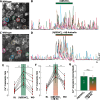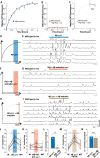β-amyloid monomer scavenging by an anticalin protein prevents neuronal hyperactivity in mouse models of Alzheimer's Disease
- PMID: 38987287
- PMCID: PMC11237084
- DOI: 10.1038/s41467-024-50153-y
β-amyloid monomer scavenging by an anticalin protein prevents neuronal hyperactivity in mouse models of Alzheimer's Disease
Abstract
Hyperactivity mediated by synaptotoxic β-amyloid (Aβ) oligomers is one of the earliest forms of neuronal dysfunction in Alzheimer's disease. In the search for a preventive treatment strategy, we tested the effect of scavenging Aβ peptides before Aβ plaque formation. Using in vivo two-photon calcium imaging and SF-iGluSnFR-based glutamate imaging in hippocampal slices, we demonstrate that an Aβ binding anticalin protein (Aβ-anticalin) can suppress early neuronal hyperactivity and synaptic glutamate accumulation in the APP23xPS45 mouse model of β-amyloidosis. Our results suggest that the sole targeting of Aβ monomers is sufficient for the hyperactivity-suppressing effect of the Aβ-anticalin at early disease stages. Biochemical and neurophysiological analyses indicate that the Aβ-anticalin-dependent depletion of naturally secreted Aβ monomers interrupts their aggregation to neurotoxic oligomers and, thereby, reverses early neuronal and synaptic dysfunctions. Thus, our results suggest that Aβ monomer scavenging plays a key role in the repair of neuronal function at early stages of AD.
© 2024. The Author(s).
Conflict of interest statement
A.S. is founder and shareholder of Pieris Pharmaceuticals, Inc. Anticalin® is a registered trademark of Pieris Pharmaceuticals GmbH, Germany. All other authors declare no competing interests.
Figures






References
MeSH terms
Substances
Grants and funding
LinkOut - more resources
Full Text Sources
Medical

